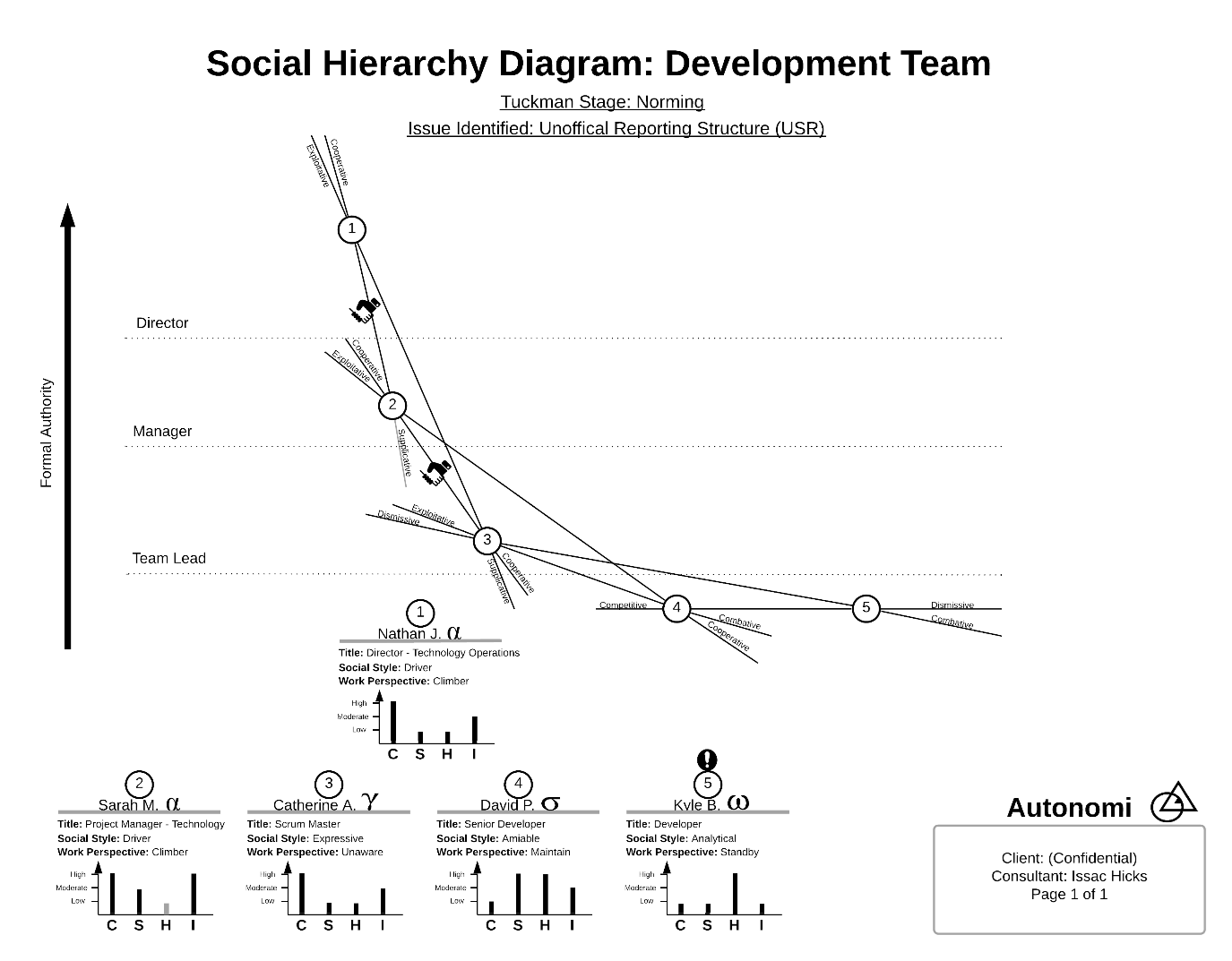
Case Study: Unofficial Reporting Structures
Symptoms
Missed Deadlines, Disillusioned EmployeesAltitude
DirectorIncentive
Career ProgressionCohesion Structure
Quid Pro QuoThe Duality of the “Go-Getter”
Ambitious, forward-thinking individuals are amongst the highest value employees available to an organization. Usually conscientious by nature, these individuals are the ones who reliably produce large amounts of value, learn and adapt quickly, take on responsibilities proactively, and quickly become an integral part of the function of an organization. Always proving to be a strong and stable part of the team, these are the people we are normally referring to when we talk about “talent” in terms of the workplace.
However, there exist certain organizational climates that can bring out the darker side of the talent pool. Organizations that strongly value hierarchal authority, have payscales that grow exponentially with altitude or contain other triggers can incentivize their employees to explore potentially damaging methods of growing within the company.
One such method is the formation of Unofficial Reporting Structures. In this social system, individuals at multiple levels of organizational altitude form an informal, information-sharing alliance. This alliance provides the higher levels of altitude with greater visibility than their peers, giving them an edge in the competition for limited promotion opportunities. Those lower in altitude, in exchange, receive the opportunity to “ride the coattails” of those higher in the chain. This shared informational structure also provides the higher-level individuals a strong form of organizational control, allowing them to manipulate situations for the benefit of those within the system. Unfortunately, these manipulations usually result in significant lost time and wasted spend for the organization.



A Closer Look - How These Structures Form
Note: This section will be using concepts and terminology that may be unfamiliar to those without a background in organizational dynamics. Please download our whitepaper here for a deeper explanation of the topics covered below.
Unofficial Reporting Structures form when an individual at a higher level of the organization seeks to further increase their career altitude. These individuals tend to be heavily career-focused and demonstrate a strong command of the way things “really” work in the company (i.e. they are “Climbers.”) With a motivation for career progression that supersedes their motivation for skill progression or perceived impact, these individuals attempt to optimize their chances of success by assuming control over the narrative surrounding his own performance in comparison with their peers.
In order to take control of the narrative, the forward-thinking employee realizes that they need to have a clear picture of the current organization narrative. However, at higher levels in the company, the visibility an individual has into their peers’ reporting structures is minimal. To remedy this, the individual will begin inquiring for more information from those below them in the corporate hierarchy. A rather dominant individual will quickly succeed at creating a dynamic in which a lower-level employee is now directly reporting to them in an unofficial capacity. The new report is also strongly career-focused above all else and quickly realizes that this newfound relationship is their ticket to improving their own position.
Wanting to be as valuable a report as possible (thus locking in their next promotion), the new report quickly realizes that they will be able to get the most information by enlisting a report underneath themselves to provide them with more visibility. This chain reaction of reporting progresses down the formal organizational hierarchy, until such point that it reaches the entry-level, or is otherwise halted by a reporter who is unaware of (or disinterested in) the opportunity for advancement this structure offers.
As the reporting structure grows, the originator uses their newfound visibility to influence the ongoing processes in their peers’ organizational reporting structures. Either through direct commands to their URS or action on information gathered from them, the originator then uses his position in the company to influence policies in a way that causes disruptions in the workflow of peers’ teams. As a result, the originator is able to fulfill their intended result and appears to be the best option for promotion amongst their peers. Those who were involved in the reporting structure all receive an exclusive opportunity to move up. The system perpetuates while senior leadership, unaware of this dynamic, struggle to determine why they continue to miss key milestones and miss critical KPIs.
Unofficial reporting structures are especially difficult to identify when they consist of individuals who are also in the originator’s formal reporting hierarchy. In these cases, the alliance will progress through a series of clique-like interactions in which those in the lower levels of the hierarchy are made to believe that they are more valuable to the organization than their peers. This creates a sense of “drift” within the team, as the individuals within the reporting structure become increasingly socially distant from their peers.
The Path to Remediation
Unofficial Reporting Structures form due to an exploitation of the lack of downline visibility and control senior leadership has. Relying mostly on ad-hoc reporting and grapevine narratives, senior leadership makes decisions regarding advancement using their perception of the situation. It is this very perception that the URS seeks to corrupt. Unofficial reporting structures rely on the compounded distortion of information that occurs as information filters up the organizational chain.
In order to combat a URS, cross hierarchical transparency is key. Enablement can be accomplished using both technological means (such as real-time dashboards for “boots-on-the-ground KPIs) and sociological means (such as the gap-wise 360 performance reviews, “flat” hierarchical infrastructures, and organized “top-to-bottom” check-ins). In practice, an in-depth investigation of the organizational dynamics of a given company is required to diagnose the exact underlying incentivization system that gave rise to a particular structure.



